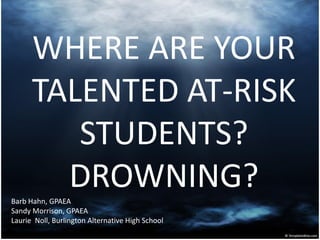
Talented And Gifted At Risk Presentation 040710
- 1. WHERE ARE YOUR TALENTED AT-RISK STUDENTS? DROWNING? Barb Hahn, GPAEA Sandy Morrison, GPAEA Laurie Noll, Burlington Alternative High School
- 2. U.S. schools spend $8 billion on the mentally retarded and just 10% of that on the gifted (TIME 8/27/07)
- 3. Between 2-5 percent of all students are both gifted and talented and learning disabled (Dix & Schafer, 1996)
- 4. Of the 62 million school-age kids in the U.S., 62, 000 have IQs of 145 or higher (TIME 8/28/07)
- 5. High-IQ kids who skip at least three grades are the happiest and most successful (TIMES 8/27/2007)
- 6. 40% of the top 5% of graduates fail to finish college (Times 8/27/07)
- 7. Underachievement is made up of a complex web of behaviors, but it can be reversed by parents and educators who consider the many strengths and talents possessed by the students who may wear this label (Delisle & Berger, 1990)
- 8. Questions to Ask • How many talented and gifted students do you have identified? • Who are your TAG students? • How can you identify them? • What is the attendance rate of your TAG students? • How is their behavior in school? • Are they making the grades?
- 9. It's all about standing out... STUDENT STUDENT STUDENT STUDENT STUDENT TALENTED AT STUDENT RISK STUDENT
- 10. Areas of Giftedness • General Intellectual • Specific Academic • Leadership • Visual and Performing Arts • Creativity
- 11. Multiple criteria for identification must be used including potential, achievement, leadership, creativity, product, evaluations, and nomination. A pupil may be identified in more than one category.
- 12. Twice Exceptional • Attention Deficit • Health Problems • Learning Disabled • Gifted does not protect you from a disability or life experiences.
- 14. Minimize the barriers; Maximize the child ~ Colangelo •Adult responsibilities •Unstable home life •Health & Learning Disabilities •Mental Health Issues •Lower SES •High mobility •Homeless •Absenteeism •Childbirth/sick child •Cultural attitude about achievement •Environment •Interpersonal attitudes about giftedness
- 15. Rejection and failing grades become the norm
- 16. Gradual Release of Responsibility Teacher Responsibility Focus Lesson “I do it” Guided Instruction “We do it” Collaborative “You do it together” Independent “You do it alone” Student Responsibility
- 18. Ask students: What is your passion? What do you want to learn? Listen and Brainstorm for best results
- 21. Every young person needs and deserves: 1. A one-on-one relationship with a caring adult 2. A safe place to learn and grow 3. A healthy start and a healthy future 4. A marketable skill to use upon graduation 5. A chance to give back to peers and community Milliken, 2007
- 22. Focus on what we can do! When we focus we do make a difference!
- 24. Relevance
- 25. A LESSON WITH RELEVANCE ASKS STUDENTS TO: USE THEIR KNOWLEDGE TO TACKLE REAL-WORLD PROBLEMS THAT HAVE MORE THAN ONE SOLUTION.
- 26. A LESSON WITH RIGOR ASKS STUDENTS TO: EXAMINE PRODUCE CLASSIFY DEDUCE GENERATE ASSESS CREATE PRIORITIZE SCRUTINIZE DECIDE
- 27. What can you do? • Find teachers that motivate students • Give up complacency • Find your gifted students
- 28. “Convince me that you love children.” ~ Frank Schargel
- 29. Encourage Every Star To Shine
- 31. You have these gifted students They do not need to be perfect in all areas They may be impacted by at-risk factors and disabilities TAG students need to be recognized so we do not lose our treasures.
- 32. Your Challenge TALENTED AT RISK STUDENT Find underserved gifted students by using a broad definition of giftedness and a multiple criteria approach with unique and appropriate identification strategies
- 34. We have the privilege to help students achieve their dreams and open their treasures.
- 35. Goals for all students: Success for their Future
- 37. Questions